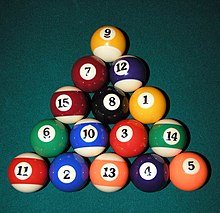Pool, also more formally known as pocket billiards (mostly in North America) or pool billiards[1] (mostly in Europe and Australia), is the family of cue sports and games played on a pool table having six receptacles called pockets along the rails, into which balls are deposited as the main goal of play. An obsolete term for pool is six-pocket.[2]
There are hundreds of pool games. Some of the more well known include eight-ball (and the variant blackball), nine-ball (with variants ten-ball and seven-ball), straight pool (14.1 continuous), one-pocket, and bank pool.
There are also hybrid games combining aspects of both pool and carom billiards, such as American four-ball billiards, cowboy pool, and bottle pool.
The Oxford English Dictionary states that pool is generally "any of various types of billiards for two or more players" but goes on to note that the first specific meaning of "a game in which each player uses a cue ball of a distinctive colour to pocket the balls of the other player(s) in a certain order, the winner taking all the stakes submitted at the start of the contest" is now obsolete, and its other specific definitions are all for games that originate in the United States.[3]
In the United States, although the original "pool" game was played on a pocketless carom billiards table, the term later stuck to all new games of pocket billiards as the sport gained in popularity,[citation needed] and so outside the cue sports industry, which has long favored the more formal term pocket billiards, the common name for the sport has remained pool. The OxfordDictionaries.com definition no longer even provides the obsolete meaning found in the print edition, and refers only to the typical game "using two sets [each] of seven coloured and numbered balls ... with one black ball and a white cue ball" on a table with pockets.[4]
Equipment
Standard pool balls
The balls range from 2.25 inches (57.15 mm) in diameter to 2.375 inches (60.33 mm) in diameter.[5] Under the WPA/BCA (see below) equipment specifications, the weight may be from 5.5 to 6 oz. (156–170 g) with a diameter of 2.25 in. (57.15 mm), plus or minus 0.005 in. (0.127 mm).[6][7] Modern coin-operated pool tables generally use one of three methods to distinguish and return the cue ball to the front of the table while the numbered balls return to an inaccessible receptacle until paid for again: the cue ball is larger and heavier than the other balls, or denser and heavier, or has a magnetic core.
Modern cue sticks are generally 58.5 inches (148.6 cm) long for pool while cues prior to 1980 were designed for straight pool and had an average length of 57.5 inches (146.1 cm). By comparison, carom billiards cues are generally shorter with larger tips, and snooker cues longer with smaller tips.
Game types
Eight-ball
Main article: Eight-ball
Eight-ball rack
Nine-ball
Main article: Nine-ball
The largest nine-ball tournaments are the independent U.S. Open Nine-ball Championship and the WPA World Nine-ball Championship for men and women. Male professionals have a rather fragmented schedule of professional nine-ball tournaments. The United States Professional Pool Players Association (UPA) has been the most dominant association of the 1990s and 2000s. A hotly contested event is the annual Mosconi Cup, which pits invitational European and U.S. teams against each other in one-on-one and scotch doubles nine-ball matches over a period of several days. The Mosconi Cup games are played under the more stringent European rules, as of 2007.[9]
Three-ball
Main article: Three-ball
A variant using only three balls, generally played such that the
player at turn continues shooting until all the balls are pocketed, and
the player to do so in the fewest shots wins. The game can be played by
two or more players. Dispenses with some fouls common to both nine- and
eight-ball.One-pocket
Main article: One-pocket
One-pocket is a strategic game for two players. Each player is
assigned one of the corner pockets on the table. This is the only pocket
into which he can legally pocket balls. The first player to pocket the
majority of the balls (8) in his pocket wins the game. The game requires
far more defensive strategy than offensive strategy, much unlike
eight-ball, nine-ball, or straight pool. Most times, accomplished
players choose to position balls near their pocket instead of trying to
actually pocket them. This allows them to control the game by forcing
their opponent to be on defense instead of taking a low percentage shot
that could result in a loss of game. These low percentage shots are
known as "flyers" by one-pocket aficionados.Bank pool
Main article: Bank pool
Bank pool has been gaining popularity in recent years. Bank pool can be played with a full rack (can be a long
game), but is more typically played with nine balls (frequently called
"nine-ball bank"). The balls are racked in nine-ball formation, but in
no particular order. The object of the game is simple: to be the first
player to bank five balls in any order (eight balls when played with a
full rack). Penalties and fouls are similar to one pocket in that the
player committing the foul must spot a ball for each foul. This must be
done before the incoming player shoots.



Tidak ada komentar:
Posting Komentar